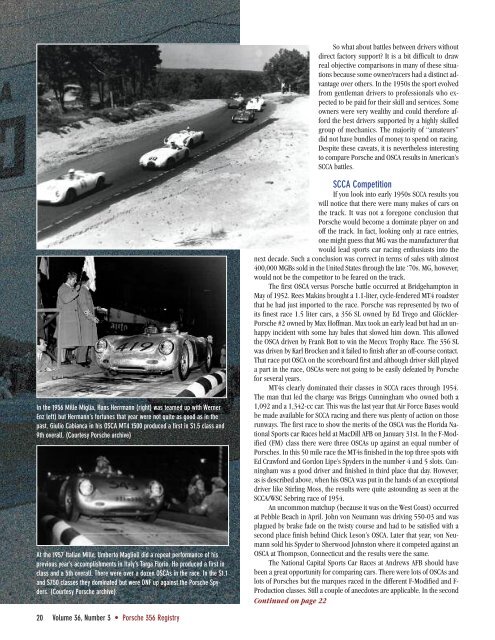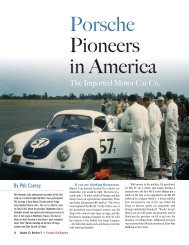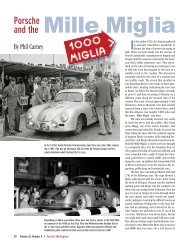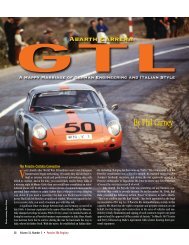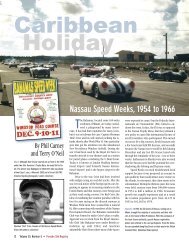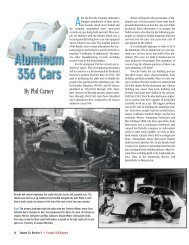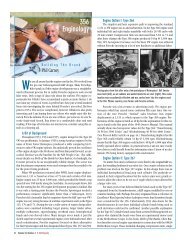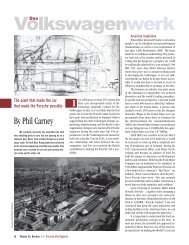You also want an ePaper? Increase the reach of your titles
YUMPU automatically turns print PDFs into web optimized ePapers that Google loves.
So what about battles between drivers without<br />
direct factory support? It is a bit difficult to draw<br />
real objective comparisons in many of these situations<br />
beca<strong>us</strong>e some owner/racers had a distinct advantage<br />
over others. In the 1950s the sport evolved<br />
from gentleman drivers to professionals who expected<br />
to be paid for their skill and services. Some<br />
owners were very wealthy and could therefore afford<br />
the best drivers supported by a highly skilled<br />
group of mechanics. The majority of “amateurs”<br />
did not have bundles of money to spend on racing.<br />
Despite these caveats, it is nevertheless interesting<br />
to compare Porsche and <strong>OSCA</strong> results in American’s<br />
SCCA battles.<br />
In the 1956 Mille Miglia, Hans Herrmann (right) was teamed up with Werner<br />
Enz left) but Hermann’s fortunes that year were not quite as good as in the<br />
past. Giulio Cabianca in his <strong>OSCA</strong> MT4 1500 produced a first in S1.5 class and<br />
9th overall. (Courtesy Porsche archive)<br />
At the 1957 Italian Mille, Umberto Maglioli did a repeat performance of his<br />
previo<strong>us</strong> year’s accomplishments in Italy’s Targa Florio. He produced a first in<br />
class and a 5th overall. There were over a dozen <strong>OSCA</strong>s in the race. In the S1.1<br />
and S750 classes they dominated but were DNF up against the Porsche <strong>Spyder</strong>s.<br />
(Courtesy Porsche archive)<br />
SCCA Competition<br />
If you look into early 1950s SCCA results you<br />
will notice that there were many makes of cars on<br />
the track. It was not a foregone concl<strong>us</strong>ion that<br />
Porsche would become a dominate player on and<br />
off the track. In fact, looking only at race entries,<br />
one might guess that MG was the manufacturer that<br />
would lead sports car racing enth<strong>us</strong>iasts into the<br />
next decade. Such a concl<strong>us</strong>ion was correct in terms of sales with almost<br />
400,000 MGBs sold in the United States through the late ‘70s. MG, however,<br />
would not be the competitor to be feared on the track.<br />
The first <strong>OSCA</strong> vers<strong>us</strong> Porsche battle occurred at Bridgehampton in<br />
May of 1952. Rees Makins brought a 1.1-liter, cycle-fendered MT4 roadster<br />
that he had j<strong>us</strong>t imported to the race. Porsche was represented by two of<br />
its finest race 1.5 liter cars, a 356 SL owned by Ed Trego and Glöckler-<br />
Porsche #2 owned by Max Hoffman. Max took an early lead but had an unhappy<br />
incident with some hay bales that slowed him down. This allowed<br />
the <strong>OSCA</strong> driven by Frank Bott to win the Mecox Trophy Race. The 356 SL<br />
was driven by Karl Brocken and it failed to finish after an off-course contact.<br />
That race put <strong>OSCA</strong> on the scoreboard first and although driver skill played<br />
a part in the race, <strong>OSCA</strong>s were not going to be easily defeated by Porsche<br />
for several years.<br />
MT4s clearly dominated their classes in SCCA races through 1954.<br />
The man that led the charge was Briggs Cunningham who owned both a<br />
1,092 and a 1,342-cc car. This was the last year that Air Force Bases would<br />
be made available for SCCA racing and there was plenty of action on those<br />
runways. The first race to show the merits of the <strong>OSCA</strong> was the Florida National<br />
Sports car Races held at MacDill AFB on January 31st. In the F-Modified<br />
(FM) class there were three <strong>OSCA</strong>s up against an equal number of<br />
Porsches. In this 50 mile race the MT4s finished in the top three spots with<br />
Ed Crawford and Gordon Lipe’s <strong>Spyder</strong>s in the number 4 and 5 slots. Cunningham<br />
was a good driver and finished in third place that day. However,<br />
as is described above, when his <strong>OSCA</strong> was put in the hands of an exceptional<br />
driver like Stirling Moss, the results were quite astounding as seen at the<br />
SCCA/WSC Sebring race of 1954.<br />
An uncommon matchup (beca<strong>us</strong>e it was on the West Coast) occurred<br />
at Pebble Beach in April. John von Neumann was driving 550-03 and was<br />
plagued by brake fade on the twisty course and had to be satisfied with a<br />
second place finish behind Chick Leson’s <strong>OSCA</strong>. Later that year, von Neumann<br />
sold his <strong>Spyder</strong> to Sherwood Johnston where it competed against an<br />
<strong>OSCA</strong> at Thompson, Connecticut and the results were the same.<br />
The National Capital Sports Car Races at Andrews AFB should have<br />
been a great opportunity for comparing cars. There were lots of <strong>OSCA</strong>s and<br />
lots of Porsches but the marques raced in the different F-Modified and F-<br />
Production classes. Still a couple of anecdotes are applicable. In the second<br />
Continued on page 22<br />
20 Volume 36, Number 3 • Porsche 356 Registry


